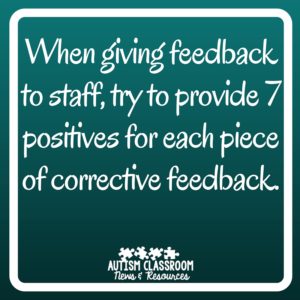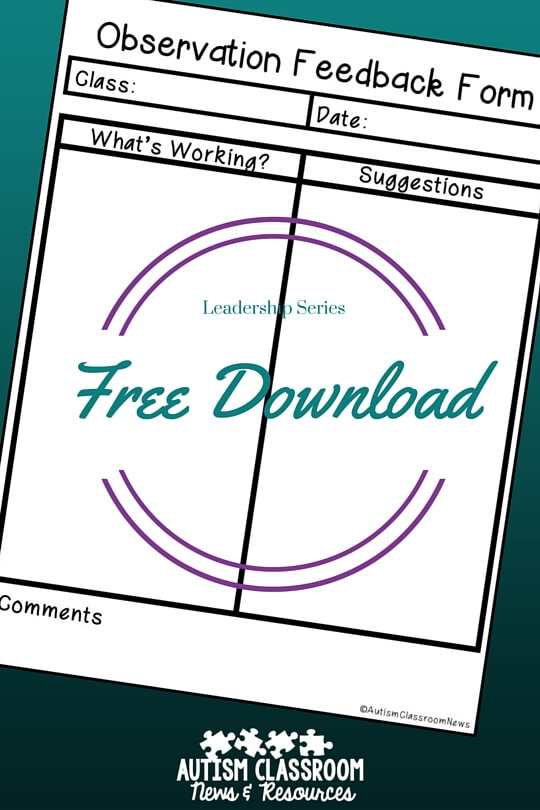All of us have to give feedback to someone at some point in our career. Whether it’s giving a friend feedback on a lesson or classroom material you just looked over was or giving feedback to a paraprofessional, giving feedback can be really tricky. If you give it effectively, the person who receive it will likely listen to it and their performance will improve. If you give it poorly, you will be living with a pretty unhappy in your classroom or work life, and possibly in your personal life. So, how can you give feedback in a way that is constructive, useful and less likely to upset the person, even when it has to be negative?
That was tonight’s discussion on Facebook Live. If you want, you can skip to the end of this post and watch or listen to the video in which I will cover the information below.
Giving Feedback to Staff

1. Don’t Forget the Positive Feedback
Yes, positive feedback is usually well accepted and easy to give and not something that necessarily deserves a blog post. However, one of the most important tenets of providing meaningful feedback is to make sure that you are consistently providing positive feedback. The behavioral research indicates that we should be providing positive feedback at about a 7 to 1 ratio–7 elements of positive feedback for every corrective feedback given. Clearly, you aren’t going to be giving all that positive feedback at one time and follow it with the corrective feedback. However, you want to make sure that you are giving positive feedback at a much higher ratio over time than corrective feedback. It make sense, after all….do you want to listen to someone who always tells you negatives?
Tips about positive feedback
I talked some about giving positive feedback in a previous post in this series. However, keep the following in mind when you are giving positives.
- Make it sincere
- Be concrete and specific about what it is based on
- Give it as immediately as possible to the action you are complimenting
- Don’t require anything in return (i.e., don’t expect a compliment back or wait for one as if you do)
- Give it noncontingently–that means give it whenever and wherever…not when you need something
2. Set the Stage
If you are sitting with someone specifically to review an observation or give them feedback, set the stage for the purpose of your observation and feedback. Talk about the end goal you have in doing it (e.g., improving everyone’s teaching skills; helping to get the classroom running more smoothly). Often I’ve found if I can focus on the goals that the person has for him/herself (e.g., an aide who wants to become a teacher, a teacher who wants to be a coach), I can frame the feedback as a way to help them grow to meet those goals.
If they don’t have those types of aspirations or goals, focus on the overall goal of the classroom team–to provide the best program for the students in the classroom. Remind them that everyone needs feedback in order to grow and serve the wide range of needs we serve in our classes. Put the feedback in context so that rather than blaming them for doing something wrong, you are helping them to do it better.
3. Layer the Negative Feedback
There is a feedback strategy known as “sandwiching.” When you sandwich feedback you give a positive, followed by corrective feedback, followed by a positive. Essentially you are using positives as bread and the corrective feedback is the meat. This is highly effective for some people and often makes it clear that you are given constructive feedback to help them, not just picking on them. Keep in mind, though, that if there is a negative relationship already developed or developing, this type of strategy can create a situation in which the listener does not feel that the positives are sincere. This is one reason the noncontingent positives you offered in #1 above are so important. Otherwise, to the listener, the positive feedback only means that something negative is coming.

Instead of using a strict sandwich of feedback, try interspersing the positive and negative from an observation, for instance, together in the discussion. One way I often do that is to break the observation or the feedback down by area of the classroom day I observed and talk about what’s working and what’s not working. This allows me to consistently provide positive and corrective feedback interwoven together in the discussion. I will use a consultation form that sets things up the same way–each activity has a “what’s working” column and a “Suggestions” column. This allows me to notice those things that are working well in the activity while I’m observing…thus making my positive feedback more concrete and real, while tempering the suggestions I’m making for things that aren’t working. You can download a free observation sheet set up this way here.
4. Give Positives Publicly and Correction Privately
This one is pretty basic, but it bears repeating because it is so important. No one wants to be corrected while everyone is watching…it’s the sure way to become upset and angry about the feedback. Not only do we want to try to keep that from being the outcome of constructive feedback for the receiver because it spoils relationships, but a person who is upset and embarrassed is not receptive and attending to the feedback you are giving. He or she is focusing on the embarrassment and they will naturally be more defensive.

There will be times when you need to correct actions immediately because what they are doing is creating bad habits or causing problems and possibly even presenting a safety problem. Clearly you have to step in during these situations. However, save the discussion about what happened for a debrief in private. Remove them from the situation if needed with as little discussion as possible. Think about saying, “Can I try something?” or “Let me see if I can help” rather than telling them to stop. Then, when things are calm, sit down privately and share with them your observations and concerns.
5. Be Concrete
When doing an observation or reviewing someone else’s work, it is most effective if you have some type of checklist, rubric or concrete example of what you the outcome goal is. I don’t use them as an evaluation; I use them as a tool and I often will share them with the people I’m observing and talk about what the elements of it entail.
Often I will do this with training and share the checklist as part of the training. If I’m using a whole program or whole classroom tool, instead of a comptency-based checklist for a specific strategy like discrete trials, I will break it down and only focus on one area of observation at a time. Bringing it back to the observation tool makes the feedback you provide more objective and it’s more difficult to take it personally. I am going to share some tools in my store this summer for this. In the meantime, though, here are some tools that might be helpful.
For individual strategies, the National Professional Development Center on Autism Spectrum Disorders has implementation checklists for the evidence-based practices that you can download and use for this.
Colorado Department of Education Autism Spectrum Disorder Classroom Observation
PEPSA Learning Curve Observation Tool
6. Build a Relationship
It is critical in giving feedback that you have gotten to know the person and have begun to develop a relationship with him or her. Without that rapport and that context, giving feedback is difficult. If you are new to the classroom (e.g., a new teacher, a new consultant or coach coming into the room), give corrective feedback more sparingly. Unless there are safety concerns, give little pieces of corrective feedback (while really giving lots of positives). Choose feedback that they are likely to agree with you about and want to change. Don’t tackle the bigger problems (if you don’t have to) until you have a better relationship with the person.
One of the things my colleagues and I have talked about is the fact that I can often tell what needs to happen in a classroom within the first 5 minutes of being in it. The rest of the time I spend is for helping the staff believe that I’ve seen enough and to build that rapport with them. Consequently my first observations in a classroom are significantly longer than future ones, unless there are problems, because I have a rapport I can trade on and a shared context and goal for the room that I can put the feedback into when I deliver it. I use that extra time to gather the positive observations, share positives I see as they occur, and spend time getting to know the classroom better.
[socialpug_tweet tweet=”It’s important to build relationships prior to giving corrective feedback in the special ed classroom. #classroomculture #specialed #classroommanagement” display_tweet=”It’s important to build relationships prior to giving corrective feedback in the special ed classroom. ” style=”2″]
7. Individualize
Everyone takes feedback differently and we need to individualize the way we present it. Some people need lots of positive feedback for each thing you want to suggest…more than the 7:1 ratio. Some people just want to know what they can do and don’t want to be “mollycoddled” by you. And some are going to be really tough to get through at all and are going to require a great deal more time to build a relationship with before you can even start to give corrections to them and have them accept them.
So know the preferences and style of the person you are working with. Again, if they are new, hold back on the corrective feedback until you have built a stronger relationship with them. Even if they resent your intrusion into their classroom (or part of the classroom), eventually they will realize you are there to stay is you just keep coming back and giving positive feedback. If you also join in and help in the classroom during these times, they may even begin to respect you for it…even if they might never like you.
[socialpug_tweet tweet=”Different people want their feedback in different ways, so individualize. #feedback #classroomfeedback #specialed ” display_tweet=”Different people want their feedback in different ways, so individualize.” style=”2″]
8. Watch Your Tone and Nonverbals
Obviously when you are presenting feedback, it’s important to assure that your tone of voice expresses support for helping the person, not frustration. This is hard sometimes and applies to your nonverbal presentation as much as your verbal. If you confront a person with negative feedback and it comes across as highly critical, you will lose their attention before you get started. Sometimes it isn’t just your words, but your tone of voice and body language that make your feedback seem overly critical. Remember that your focus in giving feedback always has to be on supporting the person and helping her grow. Here are some tips for keeping your delivery in check with your message.
- Try to avoid using absolute types of words like “always” or “never” –the person will always find exceptions and use them to argue. If you stick with #5 of being concrete, you can avoid this problem.
- Be inclusive in your feedback as much as possible. If you make all the negative feedback on what just this person is doing wrong, it will become overly negative. Conversely, if you focus giving the negative feedback in some context that many of us struggle with some of the same issues, you will align yourself with the person and emphasize the collaborative process.
- Relax and lean back. I know that giving negative feedback is not easy and its’ stressful. As a consequence, we tend to sit forward and get in others’ space, having our shoulders start to shrug and generally tense up. To others these nonverbals look like you are being intense and accusing. The more you relax the more you convey that this is not a huge big deal and you can work on it together.
9. Ask How You Can Help
This is an extra step that often gets left behind but is so important for change to actually happen. It’s important to create an action plan for how the suggestions will be implemented in order for change to occur. However, it’s equally important to create an action plan that is more than just dates and deadlines. You can build the importance of the team by having the educator work with you to make goals of things she is willing to try and put in place. Then work with her to set some deadlines for when things can be done. However, going the extra step of asking how you can help the person meet the goals you set together allows you to emphasize the fundamental nature of teamwork and let them know that they are not alone and you are working together.
10. End on a Positive
Never leave someone with the negative feedback to sit and stew about when you go. If you have an action plan, it’s easy to complete that plan and then just circle back to the good things and things that are working. You always want to end it on a positive because that is the feeling that the person will take away from the experience. If things have been rocky in the discussion, try to make a point of coming back to the things you really liked and noted…repeat them in different ways. If they didn’t like your feedback, just leave it at the positive for now and maybe choose 1 thing to try. Focus on helping them understand that it is “trying” and that it isn’t black and white–they don’t have to do it forever if it isn’t working.
Always remember that there is more than one solution for every problem. And on that note, I’m going to leave it until next Sunday when we will talk about how to handle it when the feedback process doesn’t go well and how to proceed with situations that are primarily negative.
Check out the Facebook Live Video
Unlock Unlimited Access to Our FREE Resource Library!
Welcome to an exclusive collection designed just for you!
Our library is packed with carefully curated printable resources and videos tailored to make your journey as a special educator or homeschooling family smoother and more productive.


